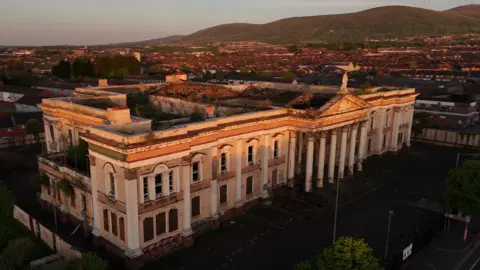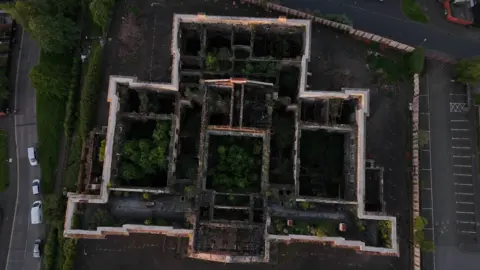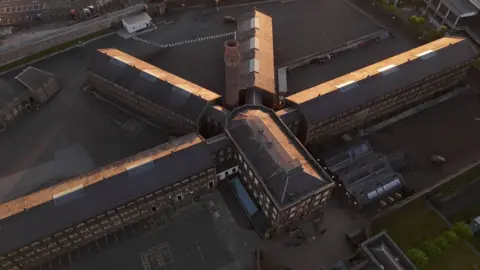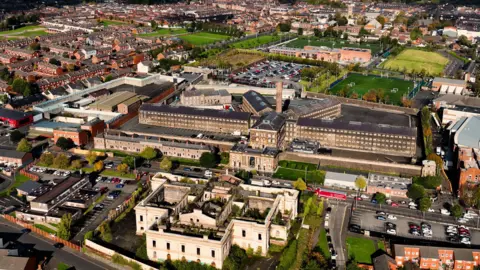Contrasting fortunes of two listed Victorian buildings on same street
 BBC
BBCOn a street in north Belfast, two Victorian buildings with colourful histories sit facing each other.
The Crumlin Road Courthouse and the Crumlin Road Gaol have had very contrasting fortunes since they both closed in the 1990s.
The jail, which is owned by the Department for Infrastructure, has been transformed into a popular tourist attraction, a conference and wedding venue and is also now home to a whiskey distillery.
Meanwhile on the other side of the road the courthouse lies empty and derelict.
It has been targeted in numerous arson attacks and is a shell of its former self, with weeds and trees growing where its roof once was.
However, new plans have now been submitted for a mixed-use development which could turn it into a hospitality, tourism, educational and commercial space.

What is planned for the courthouse?
Both buildings were constructed in the mid-19th Century and designed by the architect Sir Charles Lanyon.
The courthouse has changed hands a number of times since it closed in 1998 but various development plans have failed to get off the ground.
Its new owners are hoping their proposals will prove more successful.
Their plans include the restoration of the Victorian front of the building and the recreation of one of its courtrooms.
A tunnel beneath the road, which connected the courthouse to the jail, would be reinstated and there would be a partial demolition and new build to the rear.
'Heritage seems to degrade'
Johann Muldoon from Manor Architects is involved in the new scheme.
"For most of our heritage in Northern Ireland, we see all these proposals, but they really struggle to find a sustainable use that is economically viable," she said.
"That is why I think a lot of our heritage seems to degrade."
She hopes the mixed use plan for the site might improve its chances.
"Why we have those proposed uses is to balance what we've got in terms of heritage offering, in terms of a tourism, against the commercial viability and the sustainability of it all."

Who was in Crumlin Road Gaol?
The sorry state of the courthouse stands in contrast to Crumlin Road Gaol on the other side of the road.
Its former inmates included the likes of former Irish taoiseach (prime minister) Eamon De Valera, former Northern Ireland first minister Ian Paisley and IRA hunger striker Bobby Sands.
It closed as a working prison in 1996 and is now a popular tourist attraction where the public can visit the cells and learn about its history.
Local historian Michael Liggett, who used to give tours of the jail, thinks it is essential that its past is never forgotten.
"While there are people who take a stance that all this should be destroyed and you should forget about it, I wouldn't agree with that," he said.
"I think local history is told from our perspective - a working-class perspective - and it's hidden and it shouldn't be hidden."
 Getty Images/Ballygally View Images
Getty Images/Ballygally View ImagesLast year a whiskey distillery opened in one of the wings.
John Kelly, chief executive of McConnell's Irish Whisky Distillery, was among those behind the development.
"A wing lay derelict for many, many years, and we saw the opportunity of bringing the McConnell's story, dating back to 1776, into a wonderful heritage listed building," he said.
"For us, it's three parts of the business: it's the brand, it's the distillery and it's a wonderful tourist attraction."
Storytelling
So can the courthouse learn anything from its opposite neighbour and should we as a society do more to protect our built heritage?
Rita Harkin, the Architectural Heritage Fund's development manager for Northern Ireland, said: "We have to be able to use these buildings to tell our stories.
"And that's a reflection of a city and a place that it's grown in confidence, to be able to look honestly at our past to use that to move forward."
You can hear more on this story on The View at 22.40 BST on BBC One on Thursday or by listening to the latest episode of Red Lines.
